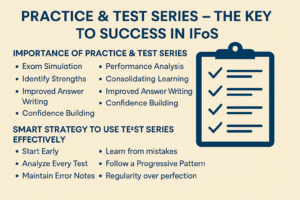The UPSC Civil Services Mains Examination is a true test of knowledge, clarity of thought, and articulation. Unlike Prelims, which is objective in nature, the Mains stage requires aspirants to write structured, analytical, and concise answers within a limited time. Many aspirants possess excellent knowledge but fail to clear Mains due to poor answer writing skills. Therefore, mastering the art of writing high-scoring answers is crucial for success in UPSC.
In this article, we’ll explore strategies, tips, and techniques to improve answer writing for UPSC Mains and maximize scores.
Why Answer Writing Practice is Important
Time Management – You have to write around 20 questions in 3 hours. Without practice, speed suffers.
Presentation Skills – Even if you know the answer, poor structure and lack of clarity can cost marks.
Content Relevance – Writing to the point and addressing the demand of the question is key.
Answer Quality – Mains is about analysis, not just facts. Your ability to link concepts with current affairs is tested.
Scoring Edge – A well-presented, well-structured answer can add 0.5 to 1 extra mark per question, leading to a 100+ marks difference overall.
Key Components of a High-Scoring UPSC Mains Answer
1. Understand the Question Demand
Carefully read the directive words like Discuss, Examine, Critically Analyze, Evaluate, Elucidate.
Frame your answer according to what is being asked, not what you want to write.
2. Structure is Everything
A good UPSC Mains answer usually follows the Introduction – Body – Conclusion (IBC) format.
Introduction – Define the concept, quote a relevant committee/thinker, or set the context.
Body – Use subheadings, bullet points, diagrams, and flowcharts to explain.
Conclusion – End with a futuristic outlook, policy suggestion, or constitutional value.
3. Use Diagrams, Flowcharts & Maps
Visuals save time and make your answer stand out.
Geography → Maps.
Polity → Flowcharts.
Economy → Simple graphs.
4. Enrich with Examples and Data
Quote reports: NITI Aayog, Economic Survey, ARC Reports.
Use Constitutional Articles, Supreme Court Judgments, and schemes.
Link with Current Affairs to show awareness.
5. Maintain Balance in Analysis
For “Critically Examine” type questions, write both positives and negatives before giving your balanced view. Avoid one-sided answers.
6. Language and Presentation
Keep it simple, clear, and concise.
Avoid long, cluttered paragraphs.
Use bullet points where possible.
7. Practice with PYQs & Test Series
Write at least 3–4 answers daily.
Simulate exam conditions weekly.
Review model answers but don’t copy them — develop your own style.
8. Time Management During the Exam
7 minutes per 10-marker, 11 minutes per 15-marker.
Don’t get stuck on a single question. Attempt all questions.
9. Value Addition Tools
Quotations from leaders or philosophers.
Case Studies in GS Paper II & IV.
Keywords like “inclusive growth”, “sustainable development”, “cooperative federalism”.
10. Consistency is Key
Regular practice builds speed, clarity, and confidence. Daily answer writing ensures you are exam-ready and adaptable to any question.
FAQs on UPSC Mains Answer Writing
Q1. How long should an ideal answer be in UPSC Mains?
An ideal answer is around 150–200 words for a 10-marker and 250–300 words for a 15-marker, depending on the demand of the question.
Q2. Should I write in paragraphs or bullet points?
A combination of both works best. Use paragraphs for introduction & conclusion and bullet points for the body.
Q3. How many answers should I practice daily?
At least 3–4 answers per day. Increase frequency as the exam approaches.
Q4. Is handwriting important for UPSC Mains?
Legibility matters, but artistic handwriting is not required. Write neatly and leave enough spacing between points.
Q5. How to add value to answers?
Use data, diagrams, reports, judgments, current affairs, and case studies. Ending answers with a positive and solution-oriented conclusion adds great value.
Q6. Should I attempt all questions even if I don’t know fully?
Yes. Even partial answers with structure and relevant keywords can fetch 1–2 marks, which may make a big difference.
Final Words
Writing high-scoring answers in UPSC Mains is not about perfection in knowledge; it’s about clear, structured, and analytical presentation of ideas within time. With regular practice, use of examples, and smart structuring, aspirants can significantly boost their scores and improve their chances of clearing the exam.










